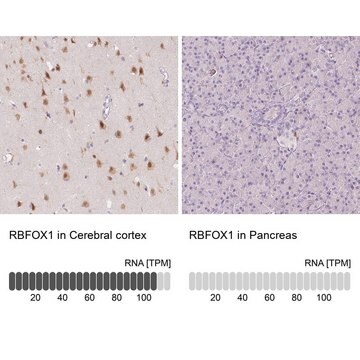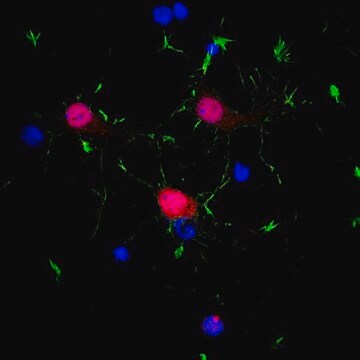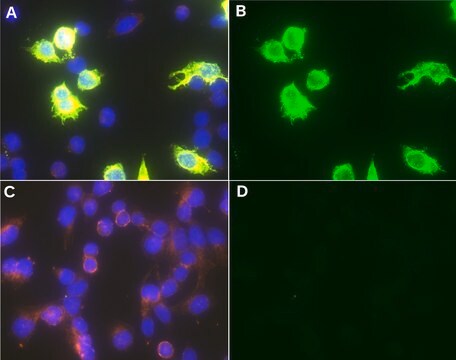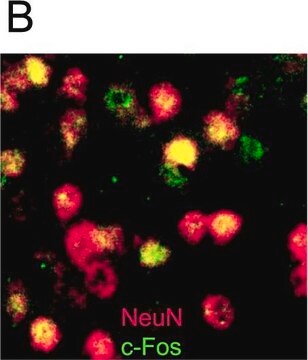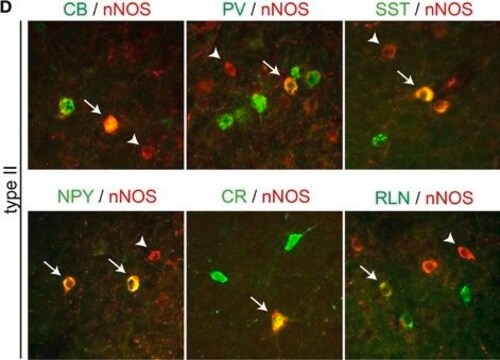MABE985
Anti-Fox1 Antibody, clone 1D10
clone 1D10, from mouse
Synonyme(s) :
RNA binding protein fox-1 homolog 1, Ataxin-2-binding protein 1, Fox-1 homolog A, Fox1
About This Item
Produits recommandés
Source biologique
mouse
Niveau de qualité
Forme d'anticorps
purified antibody
Type de produit anticorps
primary antibodies
Clone
1D10, monoclonal
Espèces réactives
mouse
Technique(s)
RIP: suitable
immunocytochemistry: suitable
immunohistochemistry: suitable
western blot: suitable
Isotype
IgG2aκ
Numéro d'accès NCBI
Numéro d'accès UniProt
Conditions d'expédition
wet ice
Modification post-traductionnelle de la cible
unmodified
Informations sur le gène
mouse ... Rbfox3(52897)
Description générale
Immunogène
Application
Epigenetics & Nuclear Function
Nuclear Receptors
Immunohistochemistry Analysis: A representative lot detected Fox1 in coronal sections from E18 mouse (Tang, Z.Z., et al. (2009). Mol Cell Biol. 29(17):4757-4765).
Immunocytochemistry Analysis: A representative lot detected Fox1 in post-mitotic neuronal cells differentiated from mouse embryonal carcinoma P19 cells (Lee, J.A., et al. (2009). Genes Dev. 23(19):2284-2293).
RNA-Binding Protein Immunoprecipitation/iCLIP Analysis: A representative lot was employed to immunoprecipitate Fox1-associated pre-mRNAs from UV-crosslinked murine cortex homogenates by individual-nucleotide resolution crosslinking immunoprecipitation (iCLIP) for characterization of Fox1 pre-mRNA-binding sites (Gehman, L.T., et al. (2011) Nat Genet. 43(7):706-711).
Western Blotting Analysis: A representative lot detected Fox1 in mouse cortical tissue homogenate (Tang, Z.Z., et al. (2009). Mol Cell Biol. 29(17):4757-4765).
Qualité
Western Blotting Analysis: 0.5 µg/mL of this antibody detected Fox1 in 10 µg of adult mouse brain tissue lysate.
Description de la cible
Forme physique
Stockage et stabilité
Autres remarques
Clause de non-responsabilité
Vous ne trouvez pas le bon produit ?
Essayez notre Outil de sélection de produits.
Code de la classe de stockage
12 - Non Combustible Liquids
Classe de danger pour l'eau (WGK)
WGK 1
Point d'éclair (°F)
Not applicable
Point d'éclair (°C)
Not applicable
Certificats d'analyse (COA)
Recherchez un Certificats d'analyse (COA) en saisissant le numéro de lot du produit. Les numéros de lot figurent sur l'étiquette du produit après les mots "Lot" ou "Batch".
Déjà en possession de ce produit ?
Retrouvez la documentation relative aux produits que vous avez récemment achetés dans la Bibliothèque de documents.
Notre équipe de scientifiques dispose d'une expérience dans tous les secteurs de la recherche, notamment en sciences de la vie, science des matériaux, synthèse chimique, chromatographie, analyse et dans de nombreux autres domaines..
Contacter notre Service technique